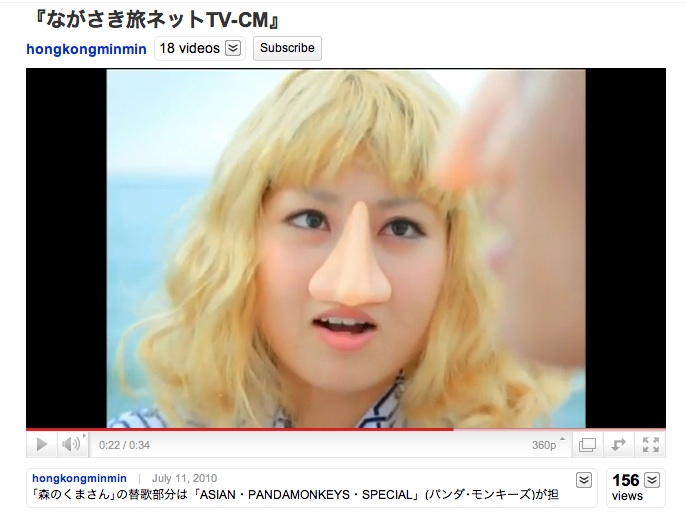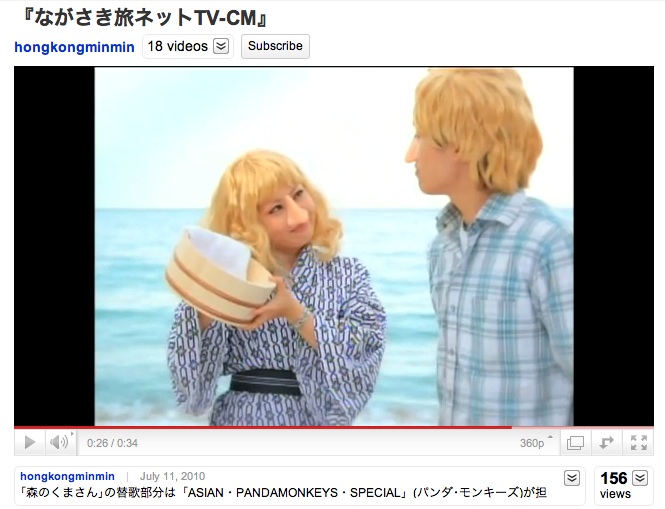mytest






![]()

UPDATES ON TWITTER: arudoudebito
DEBITO.ORG PODCASTS on iTunes, subscribe free
Hi Blog. Debito.org Reader RN sends this:
September 19, 2010
Hi Debito, Hope all is well. Not sure if I’ve told you this before but I own a Slingbox in Fukuoka which allows me to watch live Japanese television from home here in the USA. This evening I was watching 福岡放送 (FBS) and saw a commercial that was apparently trying to depict two Japanese people feeling like they were in a foreign country while on vacation. To make them look “foreign” they placed large noses and blonde hair on them and made them speak Japanese with a distinct foreign accent. It kind of reminded me of the whole McDonald’s Mr. James deal (not as blatant but still made me think, “What the heck?!”). I was attempting to put together screen shots, etc. for you (as my Slingbox allows me to pause and back up) but I found the commercial on YouTube. The company is ながさき旅ネット [which links to an English site sponsored by the “Nagasaki Prefecture Convention and Visitors Bureau“]. Here is the CM link:
http://www.youtube.com/watch?v=9oflFjeLo5c
(Now made “private”. New link at
http://www.youtube.com/watch?v=DUmazv7UTXI)
And here are some screen captures. How nice. Not. Arudou Debito

ENDS

18 comments on “Nagasakitabi.net uses “gaijin” stereotypes (blond wigs and fake noses) to push their website on TV”
Phoo yuck.
We’re right back to 22 years ago, with that stupid Toneruzu commercial for Yonekyu sausages.
Ever feel like Sisyphus, Debito?
Just another weird J-commercial. Nothing to lose sleep over.
Didn’t they already go through this with the Mr. James debacle? It’s starting to seem immature now, like a kid who got burned on a stove-top only to touch it again seconds later.
Xenophobia is one thing, but using racial stereotypes in this day and age, in practically ANY society, just seems so incredibly primitive. What if a similar commercial in the U.S. or Europe portrayed westerners dressed like WWII-type “Yellow Peril” stereotypes? The backlash (both domestic and international) would be massive and well-deserved. Why doesn’t the same happen in Japan? Is it really that hard for them to realise that this is offensive? Do they just not care?
It’s one step forward and 20 steps back.
What if a American put on some fake tanner, a taco and a sombrero and portrayed themselves as Mexican foreigners on a vacation to America? That would instantly be shot down as racist and be taken off. Japan already has a list of words that cannot be broadcast, so why not have a similar list of what can’t be shown within that context? How about “No stereotypes”? Jeez.
The scene was in definitely poor taste. Luckily the commercial was pretty bad too. Hopefully it will go away by itself by simply being a bad ad!
I think its only very recently, as witnessed with the Mr. James incident, that people in large numbers have started to complain and with some result. We have this website to thank for this.
Having worked for various advertising agencies and also casting,the thinking is often that “gaijin” is a flavor to be used to push certain products, and this tends to override consideration of whether or not it might be offensive until it is too late.
“Darling wa Gaikokujin” is now a tried and tested product/approach, and not many people complained about it so it is perceived as harmless, so it was suitable for use for ANA’s tourism to Germany advertisement one can see on the trains now.
— Oh yes, then we get to DWG. Plenty of NJ who should know better even think that the manga works in their best interests.
Check this if you want a chuckle about Japanese stereoptypes on You tube. The difference is that this kind of program would never happen in England now. But in Japan it is still alive and kicking. 40 year behind, eh?
http://www.youtube.com/watch?v=NkWjwrQvHWQ
It is an excerpt from a 1970s Brit comedy It Ain’t Half Hot Mum. The excerpt is called ” It Ain’t Half Hot Mum – Being Japanese”.
I’m largely indifferent to the commercial in that facepalm-and-walk-away sense, but I have a question: What do you mean that My Darling is a Foreigner doesn’t work in foreign residents best interests? The relationship between you and Mr. Lazlo beside the point, you have consistently praised Saori Oguri’s work on the manga and message behind it. Could you elaborate what’s wrong with pointing out racial discrimination does exist, yet that even then a man can help raise a family, speak fluent Japanese and basically be given the right to be human?
— He’s still rendered a gaikokujin. From the very title.
I have seen this commercial and it received the usual groan, sign and “Again..?”
However, I wanted to mentioned something in a similar vein. Has anyone seen the movie Dainihonjin (maybe differently titled, I was only half-watching it)? It is a recent parody of the Ultraman series, but instead it is a washed up superhero who morphs into a giant washed up Pro-Wrestler. It features many Japanese comedic heavy-hitters (Itao, etc.) and is genuinely a funny movie, but I want to discuss the final scene.
Spoiler Alert
In the final scene, the lead character is just getting trounced by the main bad guy until the Justice Team (or some similar sounding name) shows up just in time to save the day. The justice team are all Gaijin–evidenced by the giant noses, chins and grotesquely blond hair that is used on their Ultraman costumes. Of course, they greet the hero with really broken, Engrish (which supposedly designed at getting a cheap “har-har” from the audience). With this said. I prepared myself for the worst in terms of inadvertent racism.
But I was really surprised by how the scene played out. When the “Justice Team” starts going after the bad guy, it changes from CG (showing the bad guy as this fearsome devil) to live action (which depicts him as this play-doll devil). The Justice Team manhandles the devil with exaggerated ease, as the Japanese protagonist watches uneasily from the sidelines. Surprisingly the Justice Team don’t hold any of this over the hero and keep trying to include him throughout the fight. Even as the credits a rolling the Justice Team are reprimanding him about not being a team player, etc.
So, I still can’t figure out whether the scene was a compliment or a criticism of foreigners or Japanese. I think it is a profoundly deep ending for a Japanese comedy movie. Whether that was intentional or not, I’ll probably never know. Anyone else seen this flick or have any reactions?
I think Darling works in NJ’s best interest because it highlights how interesting, fresh and stimulating it can be to date someone different from you. I have always believed that “opposites attract” and that differences between people should be celebrated rather than feared. Extend this philosophy outside the sphere of dating and family and into society as a whole and you will have a more tolerant, accepting world.
I am Canadian and was taught that Canada is a “Cultural Mosaic” (let’s all keep our unique cultures and live together in harmony) whereas the US is a “Cultural Melting Pot” (let’s all adopt the American way of life).
Darling mirrors a cultural mosaic to me, which is why I like it.
— I see. A foreigner is the “opposite” of a Japanese.
DWG’s only saving grace is that it is possibly (Im not sure) showing the eternal “other”-the gaijin-in an “accepted” marriage with a J-lady.Wow, progress. I ve had two potential marriages in Japan derailed by the parents objecting to their daughter marrying a foreigner, so this is at least something. I suppose if I ever wanted to marry a Japanese (I don’t, but maybe after Japan signs the Hague Convention..)I can say to her parents humorously, “Darling wa gaikokujin dakara” (groan). Cheesy, but cheesy works here sometimes.
The bad points are as above-its the eternal other and his quaint (annoying) differences, and why, in 2010,should we give a flying fig that his race is different?
But there is one glimmer of hope-their “half” baby.The baby seems to be just a baby in the strip, and not “Akachan wa Half desu” so maybe its sending an unintentional, subliminal message that multi racial people will be more accepted (or hopefully not even noticed as different) in the future.
Fingers crossed.
“– I see. A foreigner is the “opposite” of a Japanese.”
No, but it is hard to deny that NJ and J are different in background and culture. Darling portrays the differences in a positive, constructive way, which is why I like it.
— Goody. Problem is that focussing on the differences forever means one never escapes being different. Being seen as the same/equal as everyone else (i.e. the differences don’t matter) should be the goal. Given the targeted audience that has developed and been nurtured over time (basically gaijin groupies), this is IMHO not the goal. But now we’re getting into matters of taste and there’s no logically arguing that.
As I had predicted the You Tube link which you had posted earlier would soon be unusable, so I downloaded the clip a few days ago, just in case. Apparently it was a good idea, because the original You Tube post was blocked today. I have just uploaded the original clip onto You Tube.
http://www.youtube.com/watch?v=DUmazv7UTXI
— Wonderful. Thank you very much indeed!!
I wonder if white people were “painted” as Africans on American TV, the TV company would get sued?
Tripe that an 11 year-old could have thought of.
Girl in CM: “It’s like we’re in a foreign country”
No, it’s like you’re in Nagasaki, stupid!!
The Nagasaki Board of Tourism is about to get a very strongly worded letter (I will send it over tomorrow after I write it if you’d like!).
Incidentally, Debito, do you know of the availability of annual foreigner registration statistics broken down by nationality (Japanese is fine)? Would the best place to look be a 白書 of some sort?
— Google, for starters. No doubt the info is out there. Thanks for protesting.
@Danny
I’ve seen lots of colorful “mooks” in Japanese bookshops with the theme of
statistical maps of Japan. Demographics, crime, gaijin, etc. by prefecture etc.
Hi Debito, if you haven’t seen it already, I think you will appreciate the AAJA Media Advisory on Jeremy Lin News Coverage:
http://www.aaja.org/news/Headliners/2012_02_22/